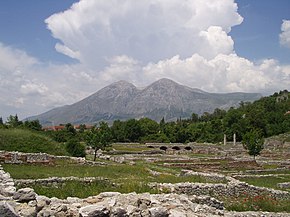Alba Fucens

Alba Fucens in front of Monte Velino. June 2003.
|
|
| Location | Massa d'Albe, Province of L'Aquila, Abruzzo, Italy |
|---|---|
| Region | Abruzzo |
| Type | Settlement |
| History | |
| Founded | 304 BC |
| Abandoned | destroyed in 10th century AD |
| Periods | Roman Republic - Byzantine Empire |
| Cultures | Ancient Rome |
| Site notes | |
| Archaeologists | Joseph Mertens |
| Public access | yes |
| Website | Area Archeologica Alba Fucens (Italian) |
Alba Fucens was an ancient Italic town occupying a lofty location (1,000 m) at the foot of the Monte Velino, c. 6.5 km north of Avezzano, Abruzzo, central Italy. Its remains are today in the comune of Massa d'Albe.
It was originally a town of the Aequi, though on the frontier of the Marsi, but was occupied by a Roman colony (304 BC) owing to its strategic importance. It lay on a hill just to the north of the Via Valeria, which was probably prolonged beyond Tibur at this very period. In the Second Punic War Alba at first remained faithful, but afterwards refused to send contingents and was punished.
After this it became a regular place of detention for important state prisoners, such as Syphax of Numidia, Perseus of Macedonia, Bituitus, king of the Arverni. It was attacked by the allies in the Social War, but remained faithful to Rome; and its strong position rendered it a place of some importance in the civil wars. Its prosperity, in the imperial period, can only be inferred from the number of inscriptions found there. The town was completely destroyed by the Saracens in the 10th century.
It is chiefly remarkable for its finely preserved fortifications. The external walls, which have a circuit of about 3 km, are constructed of polygonal masonry; the blocks are carefully jointed, and the faces smoothed. With our present knowledge of such constructions their date cannot certainly be determined. They are not preserved to any very considerable height; but the arrangement of the gates is clearly traceable; as a rule they come at the end of a long, straight stretch of wall, and are placed so as to leave the right side of any attacking force exposed. On the north there is, for a length of about 150 m, a triple line of defences of later date (possibly added by the Roman colonists), inasmuch as both the city wall proper, and the double wall thrown out in front of it are partly constructed of concrete, and faced with finer polygonal masonry (in which horizontal joints seem to be purposely avoided).
...
Wikipedia

